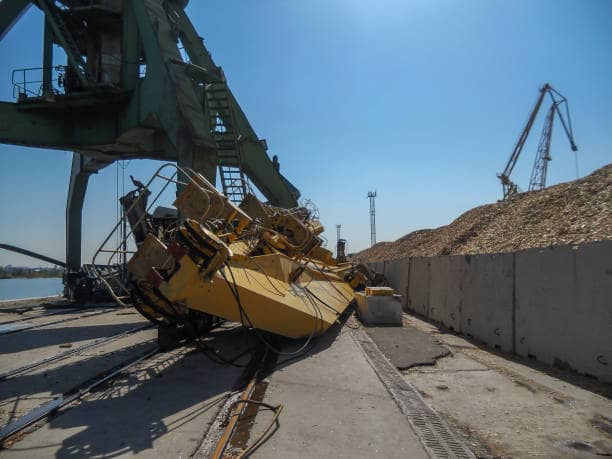Here Are The Common Causes of Crane Accidents
The average cost of injuries, illnesses, and workplace fatalities is 176 billion to $352 billion annually, which is growing at an alarming rate.
At these construction sites, heavy machinery and equipment are used. Cranes are one of them. They are used to transport materials horizontally from one place to another.
It is distressing to know that nearly 42 crane accidents occur every year. These accidents can result in significant losses of equipment and human lives.
Below are the most common causes of crane accidents.
1. Overhead Power Lines
Cranes colliding with the overhead power lines cause 39% of accidents.
In a case study, concrete water pipes were being installed by the construction company. Workers were laying support timbers when the operator extended the crane boom to lift the pipes. It came into contact with a three-phase 13,800-volt overhead power line, due to which one of the workers got a massive electrical shock while others suffered minor injuries.
Nearly 70 deaths of construction workers were reported in 2011 due to electrocutions.
These electrical shocks can cause a lot of health hazards for the workers. The aftermath of such severe electrical shocks results in nerve damage and psychological disorders. 78% of people who endured an electrical shock were given a psychiatric diagnosis.
2. Assembling and Disassembling Cranes
12% of the accidents occur while assembling and disassembling cranes.
A lamentable incident took place in 2008 when an adult man was crushed by a crane boom while he was disassembling it. The primary reason for his death was a lack of training, as he was not an employee of the construction company but the owner’s friend. When the paramedics arrived, he was pronounced dead.
Workers should be trained by professionals to teach them how to use such heavy machinery. Only a qualified disassembly team should carry out these operations. The concerned department should closely monitor these processes according to standard guidelines.
3. Rigging Failure
Rigging failures rank higher among the causes of crane accidents. 7% of crane accidents occur due to rigging failure.
These failures happen due to improper installations. These systems are essential for construction-related accidents. Therefore, they should be installed by experts only as minor problems can be fatal for your workers.
Overloading equipment can also result in rigging failure. Calculating the total load weight before lifting should be your first step before using a crane.
4. Crane Overturns
In 2006, a construction company was working on the construction of luxury houses. Two tower cranes were used for the construction of this multi-storied building.
One of the towers collapsed due to the irregular platform it was placed on. This sudden collision resulted in the death of the operator and damage to nearby buildings. After investigation, it was confirmed that the crane collapsed due to overload, poor connection between the crane and the building, and an irregular platform.
An overturned crane can result in a lot of injuries. As per the report, 7% of accidents occur because of an overturned crane.
Therefore, be vigilant of these factors to protect your workers from all potential injuries.
5. Two Blocking
Two blocking accidents occur when its arm is stretched way too much that it cannot keep the weight of the crane steady, causing it to fall. This is the most preventable cause of accidents if monitored closely, which is why they make up only 2% of crane-related accidents.
Such incidents can result in the significant loss of crane equipment as they are costly. These falling equipment are also dangerous for the workers as they can cause fatalities and injuries because of their heavy weight.
6. Boom Buckling
A boom is a structural component of a crane, and when it gets overloaded, it collapses. This sudden buckling of the boom can inflict injuries to the workers and damage to nearby structures and equipment.
8% of fatal accidents occur due to crane collapsing or boom buckling.
A case was reported in Northern Norway when the crane boom buckled while lifting bridge slabs. However, the causes of this collapse are still under question.
Another incident occurred in Scotland when a crane was set up to lift a heavy module. Due to the excessive weight, it tripped. This sudden movement caused one of the boom sections to buckle.
Fortunately, in both cases, no fatalities were reported.
7. Hoist Limitations
Hoist limitations are responsible for 1% of crane-related accidents. It does not have as much of an impact as other causes, but it is necessary to avoid them as this 1% is enough to cause you significant losses.
When workers ignore the hoist guidelines, they tend to overload it by hoisting equipment more than it can handle. This overload leads to accidents. At times, environmental conditions such as rain and strong winds can cause problems.
To avoid such inconvenience, it is important that your workers follow the guidelines provided by its manufacturer so they are aware of the hoist limitations.
8. Environmental Conditions
Sometimes the causes of crane accidents can be environmental. In February 2016, a crane collapsed in Lower Manhattan due to heavy winds. One pedestrian was killed, and three others were injured.
The investigation revealed that the crane collapsed because the workers did not properly lower the crane during strong wind conditions. The operator was held accountable for this incident.
Under extreme weather conditions, you should instruct your workers to avoid using cranes. This would help in preventing collapses.
9. Preventing Crane Accidents
To prevent falling from elevated heights, you should train your team with certified experts.
Because of human error, there is a possibility of your workers tripping. Therefore, you should facilitate them with Fall Protection Equipment.
In order to prevent electrical accidents, safe distances should be maintained from electrical wires and towers.
Only trained personnel should assemble and disassemble the crane’s related equipment.
The weight load should be calculated accurately before lifting to prevent crane turnover.
Conclusion
It is important to follow the security guidelines and protocols of every equipment. You should invest in the OSHA program such as OSHA 10-hour construction and OSHA 30-hour construction courses to protect your workers. Beyond that, you must hire an expert team to train your employees to operate cranes, as construction work cannot be performed without them. While there are different causes of crane accidents, there are also precautions that can protect life and reduce equipment damage.
By knowing the safety measures, you will be able to protect both your personnel and machinery. Thus, don’t show negligence and thoroughly read the safety manual of each machine.
Sources:
AFCIO, BLS, Digital Commons, OSHA, NCBI



